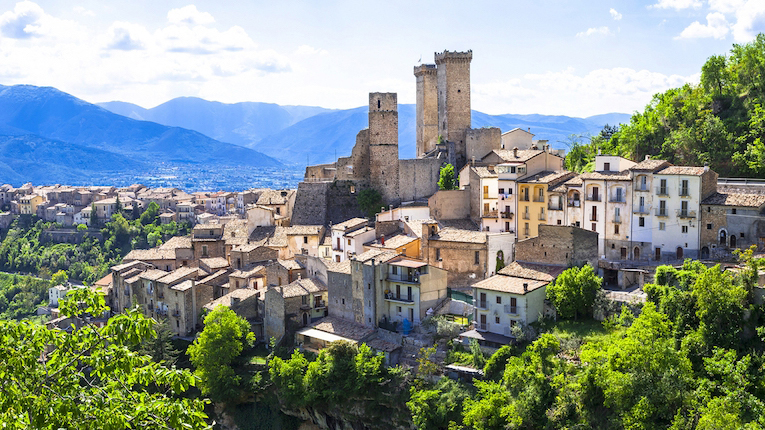The largest, most mountainous, but least populated province in the Abruzzo region is L’Aquila. Located in the western portion of Abruzzo, it comprises about half of the region’s landmass. The province includes the highest mountains of the Apennines, Gran Sasso, Maiella and Velino-Sirente; the high plain of Campo Imperatore and Europe’s southernmost glacier, the Calderone, located on the 9,554 foot tall Corno Grande.
L’Aquila is known for its many castles, fortresses and pristine medieval hill towns. The province’s two major cities, L’Aquila and Avezzano, have had rapid economic expansion since the late 20th century, with the growth of transportation manufacturing, telecommunications and computer industries.
Throughout most of the 20th century, there were serious population declines in the rural areas as people moved to cities for work. Since the founding of the Gran Sasso e Monti della Laga and Majella National Parks, tourists have been attracted to the glorious mountainous landscapes. Tourism has since boosted the economy of rural L’Aquila and has begun to reverse its population decline.
Earthquakes mark the history of the province, especially its capital city of L’Aquila. The city suffered earthquakes in the 14th, 15th and 16th centuries and most recently on April 6, 2009. This caused extensive damage to the city known as ‘the Florence of Abruzzo,’ the principle center for the arts in the region. Much of its former grandeur was lost due to the 2009 earthquake and rebuilding has taken time, but there are numerous historic sites that can be visited. It also shows the incredible force of nature and what can happen in an instant to a nearly millennium-old city when an earthquake strikes.
Located at an altitude of 2,400 feet, between four mountain peaks towering more than 6,500 feet, L’Aquila has a climate that is unusually cool for central Italy. It is only 90 minutes from Rome, but seems a world away, surrounded by snow-capped mountain peaks. The city was founded by Frederick II, the Holy Roman Emperor and King of Sicily and became the second city of the Kingdom of Naples during its heyday. Charles I of Anjoy constructed the city walls in 1316 and L’Aquila prospered due to its political position and also from the important wool trade. It became a beautiful city with palaces, monuments and bustling piazzas.
The huge Forte Spagnolo stands at the highest point of L’Aquila. Built in 1534, it is currently used as the National Museum of Abruzzo. One of the places to visit in the city is the Fountain of 99 Spouts. It has been restored and is truly a unique masterpiece. Santa Maria del Collemaggio is a crowning jewel of the city, located at one of the highest points of the town surrounded by a park. While damaged, the original facade of the Romanesque-Gothic structure is still visible with its intricate design in pink and white stone. Built in the 13th century, it was the site of the original Papal Jubilee in 1294. The penitential observation was devised by Pope Celestine V, who is buried there. The striking jewel-box effect of the exterior is due to a pattern of blocks of alternating pink and white stone; the interior, on the other hand, is massive and austere.
Located in Piazza Duomo, the Cathedral of San Massimo, dedicated to an early martyr of the Catholic Church, it is also known as Duomo dell’Aquila. The cathedral and the piazza date back to the 13th century. The cathedral was partially destroyed during the earthquake of 1703, rebuilt and then seriously damaged in 2009. Sadly, it is still too unstable to be used for services. Unlike many piazza in Italy’s major cities, there are no important palazzos along the sides of the square. This was no accident. The piazza was set aside as a place for the common people. It was also the site for many executions that took place regularly from the 14th through 16th centuries.
The town of Avezzano was completely destroyed in 1915, when it was hit by the worst earthquake in Italian history early in the morning hours of January 13th. Over 12,000 people perished in the earthquake. Only two pieces of architecture have survived – the Casa dei Palazzi and one wing of Orsini Castle. The town and even its streets had to be completely reconstructed in the Liberty-style.
The pretty hill town of Acciano is surrounded by forests of oak trees and is built on a rocky spur between the mountains and the valleys below. This village is well-known within Italy for the quality of its Montepulciano red wine. The historic center is still enclosed behind the remains of the original fortified walls, still in excellent condition. Recently, the original foundations of a square Roman temple, along with pottery fragments were discovered in the town. There is also an elaborate system of underground tunnels with evidence of mosaic floors next to the town’s cemetery.
The town of Castel del Monte is yet another location that has many narrow, underground tunnels. Known as ‘sporti,’ they were used as a means of getting safely from place to place in the village during times of siege. The center of the village is enclosed by strong walls with a high watch tower at its center.
Another medieval town is Pacentro, considered to be one of the most beautiful in all of Italy. Built on a hilly ridge 2,100 feet above sea level, it is renowned for its fresh mountain waters and springs. At one end of the town is Colle Castello, home to Cantelmo Castle. Three of its original four towers are still standing and are clearly seen as you approach the town. Near the main squares of Piazza del Popolo and Piazza Umberto, visitors will encounter numerous palazzos, as well as the beautiful 16th century Convent Church decorated in the Baroque-style. Its interior has carved choir stalls, frescoes of the life of St. Francis of Assisi, rare paintings and a collection of side altars.
In Calascio, the main attractions of the small village are the ruins of Rocca Calascio, which at 4,800 feet above sea level, is the highest fortress in the Apennines. It is located within the Gran Sasso e Monti della Laga National Park. Construction of the fortress started in the 10th century as a single watchtower. Its walled courtyard with four cylindrical towers at each corner, plus a taller inner tower was added three centuries later. The fortress was never tested in battle, but was badly damaged in 1461, when a massive earthquake stuck the area.
Sulmona is a fascinating town with many monuments, as well as a thriving artisan industry. It is famous for its delightful and inventive confetti, which are sugared almond candy presented in colorful and elaborate displays.
The Province of L’Aquila is dotted with ruins of ancient temples and Roman settlements as well as many Benedictine monumental complexes of the Romanesque age. The Church of San Pietro in Alba Fucens was built on the ruins of a pagan temple and is known for its 13th century mosaics.
The beauty of art perfectly merges with the beauty of the valleys, mountains and tablelands. If visiting the area, do not miss the plateaus of Campo Imperatore del Gran Sasso, a few miles from L’Aquila and the Tableland of Velino-Sirente.





